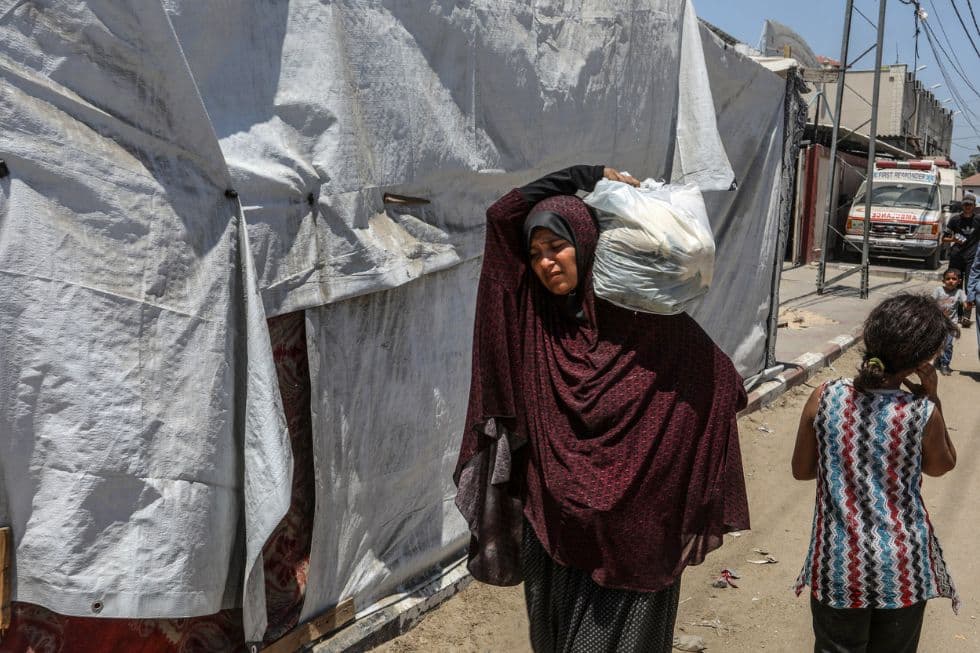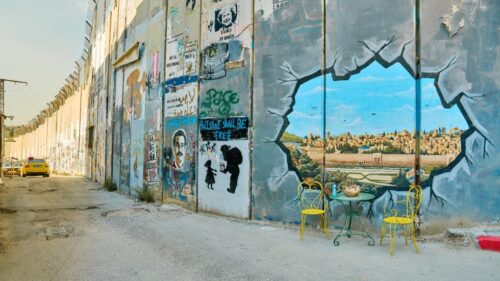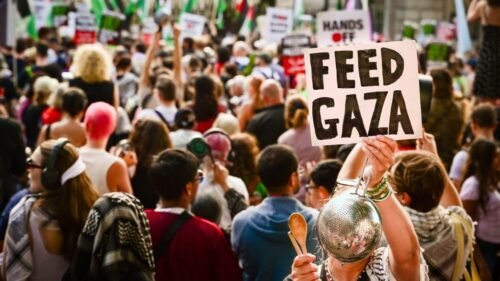Since October 7, 2023, the health condition of Palestinians in the Gaza Strip has gravely deteriorated. On August 22, 2025, the Integrated Food Security Phase Classification (IPC) released an alarming statement warning that conditions have reached stage 5 of food insecurity, in other words, a famine. The International Association of Genocide Scholars (IAGS) released a statement that Israel’s military actions meet the international definition of genocide.
In the aftermath of this devastation, this crisis must be understood within the broader context of 77 years of military occupation and, specifically, the 20-year siege of Gaza. The standard of healthcare was considerably subpar for decades and the Palestinians, especially the women, have always faced immense healthcare challenges due to a lack of infrastructure and restricted access to essential resources. Hence, the recent period of intense violence and the current health crisis should not be viewed as a new phenomenon, but as a more severe continuation of existing conditions.
General health and access to clinics and hospitals
The 20 years of blockade and the heavily fortified wall along the Gaza Strip have made it almost impossible to bring in essential medicines and healthcare equipment. Vital medical resources, such as oxygen tanks, diesel fuel for generators, ventilators, anesthetics, X-ray machines and crutches, were among the items banned from entering Gaza. In 2017, the WHO reported that 34% of essential drugs were missing and reported that out of 17 public hospitals, 14 hospitals faced the possibility of closure due to a lack of essential services. Sixteen other health facilities were likewise facing imminent closure. Basic infrastructure for building clinics was missing due to a ban on concrete and building materials. Moreover, the provision of gas and electricity was spotty and inefficient.
Since October 7, Israeli military forces have targeted the health care sector. Thirty-three out of 36 hospitals have been damaged or destroyed. On August 25, 2025, Israel double-bombed Nasser Hospital in Khan Younis, which was Gaza’s last functioning public hospital. In addition, Israel has detained over 300 healthcare workers, some of whom subsequently died in detention and murdered over 1000. This shows extensive targeting and destruction of an existing fragile healthcare system, already facing numerous challenges and obstacles.
Maternal and infant mortality as well as Palestinian women’s reproductive health
Health indices are clear indicators of the health disadvantage experienced by Palestinian women and their children in the past and present. In 2017, maternal mortality in the Occupied Territories (OTs) was 17 times higher than in Israel, whereas infant mortality was six times higher. Palestine’s OTs refer to the West Bank, Gaza and East Jerusalem.
A study in 2010 showed higher rates of congenital heart defects in Gaza than in Europe and the US. Neonatal and prenatal clinics, as well as reproductive facilities, were few in number and those that were present faced similar challenges in sourcing due to the ban on medicines and equipment. In addition, clear efforts were made by the occupying forces at checkpoints to prevent women from accessing hospital births, leading to increased birth complications and infections.
Since then, the siege has further limited women’s access to maternity clinics or neonatal care hospitals or basic medications. A targeting of a single reproductive center led to the loss of over 4000 embryos, thus harming efforts to counter the birth challenges. “Period poverty” is prevalent, as more than 450,000 women in Gaza are unable to afford sanitary products and have minimal or no access to clean water and soap. This has caused an increase in gynecological and urinary tract infections.
The psychological toll of this cannot be underestimated. Women describe feelings of shame, humiliation and a lack of dignity. Perceived as a form of “public scandal”, as they are forced to care for their basic menstrual and postpartum needs while seeking shelter in overcrowded tents, communal areas and re-using any available unhygienic rags instead of menstrual products.
Cancer, cervical and breast
Before October 7, cancer was the leading cause of death in the OTs, with a mortality rate considerably higher than in other neighboring countries in the region or in Israel. This was multifactorial: a blockade of cancer-treating drugs, a blockade of radiotherapy equipment, a lack of diagnostic tools and few available cancer treatment hospitals or clinics. Patients desiring treatment elsewhere faced extensive bureaucracy and delays.
A single referral to a regional cancer hospital and a permit to leave the OTs for treatment could take over 3 months to be approved. There was also little or no preventive care or screening tools available. A clear example of this is cervical carcinoma. In Israel, the HPV vaccine has been part of the national vaccination plans for many years now as a prevention for cervical carcinoma and access to yearly pap smears is easily available.
Palestinian women, on the other hand, commonly present late stages of cervical carcinoma and have a high level of mortality. Similarly, a report by the United Nations Population Fund, a UN agency working towards improving reproductive and maternal health, found that more than 60% of breast cancer cases are diagnosed at a late or advanced stage of disease. Since October 7, the care for cancer patients has deteriorated further in the OTs. In addition to the already lacking medicines and or treatment options, the only cancer hospital in the Gaza Strip, the Turkish Palestinian Friendship Hospital, was forced to shut down on November 1, 2023, due to a lack of fuel. The Israeli Defense Forces (IDF) completely demolished it in March 2025. Cancer patients are forced to die under siege, with little hope for cure, treatment, or pain relief.
Unclean and unsafe water sources
Access to clean water in the OTs before October 7 was unavailable or limited for many families, leading to waterborne diseases and even death. 73% of the deaths in the OTs were found to be caused by unsafe water consumption, which in many cases were preventable. A UN Women’s report stated that before October 7, more than 80% of Gaza residents depended on water supplied by trucks, and 1.1 million of its residents were not receiving adequate water. Moreover, basic sewage and water sanitation facilities were missing, as water filtration systems and sewage pumps were among the items banned from entering. In addition, industrial zones in the OTs were (and still are) exempt from regulations leading to the dumping of toxic materials into the environment.
Since October 2023, the number of water-borne diseases has increased. By October of 2024, a journal article reported over 40,000 cases of hepatitis A, infectious diseases and half a million cases of acute diarrhea were recorded in Gaza. Women, in particular, are impacted by these harms. Known as “WASH,” short for “Water, Safety, Hygiene,” physical needs and domestic roles place women in direct contact with unsafe or toxic water sources, and they, in turn, transmit any diseases to their children or families.
An example of this is polio. Polio is a preventable disease that has been eradicated in most parts of the world. In August 2024, the first case of polio in 25 years appeared in the Gaza Strip. Polio can cause paralysis, disease and death among children and unvaccinated mothers. The re-emergence of polio is a dire indicator of the deteriorating health status of Palestinian mothers and children upon exposure to water-borne diseases and untreated sewage.
Exposure to white phosphorous bombs, depleted uranium and other heavy metals
White phosphorus (WP) is a chemical that can be used as a smoke screen or as a bomb. As a bomb, WP is lethal. Only 10% of the body needs to be exposed to WP for it to be fatal. The problem with white phosphorus is that it is not adequately regulated internationally. Countries such as Israel can purchase the chemical as a smoke screen, only to use it afterward as an incendiary device.
Previously, Israel used WP to target civilians in Gaza in 2006, 2009 and 2014. WP remained within the rubble, leading to continued exposure to those rebuilding their homes. Studies showed that the children of parents who were exposed to WP from either source had a higher chance of birth defects. Neural tube defects were most common, which are defects related to the development of the spinal cord and brain. WP also resulted in higher rates of preterm babies, stunted growth and delayed milestones in their children.
Heavy metals from other incendiary devices continued to show in samples from mothers for four years after the 2014 bombings. These included barium, arsenic, cobalt, cadmium, chrome, vanadium and uranium. Depleted Uranium (DU), another unregulated toxic and lethal substance, has been increasing in Gaza since 2008. DU has been found in soil, building materials and hair of individuals. Exposure to uranium leads to kidney toxicity, cancers and birth defects. As the primary caregivers, this exposure affects both mothers and prenatal and postnatal children. The impact of repeated exposure to white phosphorus, uranium and heavy metals upon the health of survivors of the current siege and attacks will need to be addressed and studied.
Disabilities and amputees
Before October 7, according to the Palestinian Central Bureau of Statistics (PCBS), the population of Palestinians with disabilities in Gaza was between 2.6 and 5%. The number of disabilities had nearly doubled between 2007 and 2017. Another spike in the number of disabled occurred in 2018 during the “Great March of Return” when Israeli snipers aimed at protesters’ limbs.
Repeated military offenses in the OTs lead to a term known as “compounded maiming,” where an individual was injured and disabled in one event and injured again in another, leading to more than one disability. The everyday life for the disabled in the OTs was a struggle. Infrastructures were rarely accessible or accommodating for people with disabilities. Furthermore, the ban on essential physical therapy equipment, such as crutches, worsened the quality of life of the disabled Palestinians. Basic pain medications and antibiotics to prevent infection were lacking.
Only two institutions provided prosthetic devices in Gaza. Sheikh Hamad Hospital provided around 150 prosthetics a year. This hospital has been destroyed since October 2023. The Artificial Limbs and Polio Center (ALPC), built in close cooperation with the International Red Cross, cared for over 3000 patients and provided prosthetics and orthotics. It is currently not accessible to patients or care workers.
Since October 2023, there have been an estimated 3000–4000 amputations. A large number of these are children. In the current crisis, many amputations are not directly due to bombs or gunshot wounds targeting limbs, but rather due to infections and repeated trauma to the site. Amputations require long-term care, physiotherapy, follow-up to prevent further injury, in addition to psychological care and pain management.
Women amputees are more vulnerable to violence due to their restricted movement. In addition to their struggles, they are faced with caring for their disabled children as well, who have also lost their mobility and access to schooling. This is critical as more women have become the primary breadwinners of their families after the death, imprisonment or injury of their spouses or family members. Dreams of education, work and economic independence are currently far-fetched.
Starvation used as a weapon of war
In 2020, an article in Food Bulletin described a high prevalence of anemia and nutritional deficiencies in Gaza. Deficiency of essential minerals was seen in 11.4% to 84.7% of pregnant women and anemia in up to 42.8% of second and third trimester women. 70.9% of preschool children also showed nutritional deficiencies. This was due to the limited passage of nutritious elements through the crossings and checkpoints, including a ban on canned foods and due to the destruction of agricultural land for fresh food. The Israeli military was well aware of the nutritional needs of the Gaza population. The people of Gaza were and are being starved slowly, systematically and intentionally by their occupiers.
In August 2025, food insecurity reached the level of famine. Famine is defined as when 20% of households have a lack of food and are starving, and 30% of children show malnutrition. The World Food Program estimated that over 41,000 children are at risk of death due to starvation in Gaza, and over 50,000 malnourished pregnant or breastfeeding women.
The concern for starvation is not only regarding its immediate effects of disease and death, but also its long-term implications. For children or babies born to malnourished mothers, there is a non-reversible injury in their physical and cognitive development. The lack of essential nutrition leads to lower IQ and performance, as well as delayed milestones. This poses an extra challenge for society and parents, as children will require additional educational support and resources. In addition, the psychological toll of undergoing a war-induced starvation cannot be underestimated.
Post-traumatic stress disorder and gender based violence
In the years before 2023, anxiety, post-traumatic stress disorder and depression were prevalent in the West Bank and Gaza at levels higher than those seen in nearby countries. A higher rate was seen in women. This is not surprising as women are more vulnerable to gender based and sexual violence. In Gaza, up to 51% of women have been exposed to gender-based violence (GBV) either within their patriarchal systems or at the hands of the military state-sponsored terrorism. It was not just women; a UN report found Israeli military engaged in a systematic effort of sexual violence against Palestinian men and children as well.
Mental health diseases caused by assault, fear, bombardment and displacement must also be seen in the context of intergenerational trauma. The trauma experienced by grandparents can be carried through generations. The children of today’s occupation have grandparents who underwent the “1948 Nakba” at the hands of Jewish terrorist groups who were later incorporated into the IDF.
Many can still vividly recall being forced out of their homes, witnessing the massacre of their entire village and experiencing displacement or the displacement of their neighbors. Currently, there are an estimated 5.1 million Palestinian refugees globally. Treatment of mental illness in the context of a 77-year-old occupation needs extensive support and resources from mental health officials, community-based nongovernmental organizations (NGOs) and the rebuilding of family bonds and community support systems.
The task of rebuilding the health sector in Gaza is a daunting one. The reconstruction plan proposed by the government of Egypt projected a price tag of an estimated $6 billion. In reality, it will likely be a much larger number than that. In addition to funds, expertise is needed in every aspect to ensure the system is rebuilt to humane standards and long-term sustainability. Cooperation between the government and NGOs will be invaluable for this endeavor.
Palestinians, living under occupation, must be given their freedom, equal access to health care as Israeli citizens and the ability to move freely in the region to acquire the healthcare that they need. Women, in particular, will need extra care concerning their reproductive health, psychological care, prenatal and post-partum care, as well as resources for their disabled, diseased and cognitively impaired children suffering from the long-term effects of starvation and war.
The ban and blockade of medicines, equipment, nutritional substances, building materials, etc., must end. A lasting ceasefire and a permanent solution to the 77-year-old occupation are crucial for creating the necessary political, social and economic stability required for the healthcare sector’s reconstruction efforts to succeed.
[Aysha Sadak Meeran edited this piece.]
The views expressed in this article are the author’s own and do not necessarily reflect Fair Observer’s editorial policy.
Support Fair Observer
We rely on your support for our independence, diversity and quality.
For more than 10 years, Fair Observer has been free, fair and independent. No billionaire owns us, no advertisers control us. We are a reader-supported nonprofit. Unlike many other publications, we keep our content free for readers regardless of where they live or whether they can afford to pay. We have no paywalls and no ads.
In the post-truth era of fake news, echo chambers and filter bubbles, we publish a plurality of perspectives from around the world. Anyone can publish with us, but everyone goes through a rigorous editorial process. So, you get fact-checked, well-reasoned content instead of noise.
We publish 3,000+ voices from 90+ countries. We also conduct education and training programs
on subjects ranging from digital media and journalism to writing and critical thinking. This
doesn’t come cheap. Servers, editors, trainers and web developers cost
money.
Please consider supporting us on a regular basis as a recurring donor or a
sustaining member.
Will you support FO’s journalism?
We rely on your support for our independence, diversity and quality.










Comment